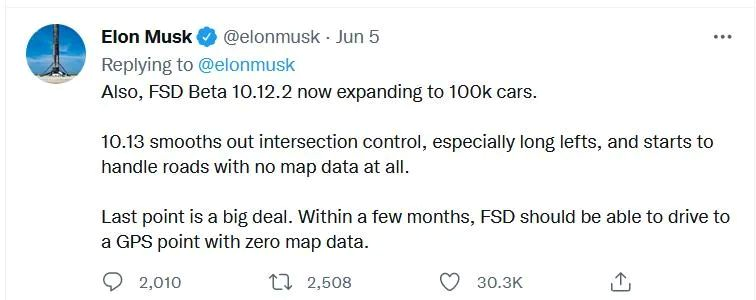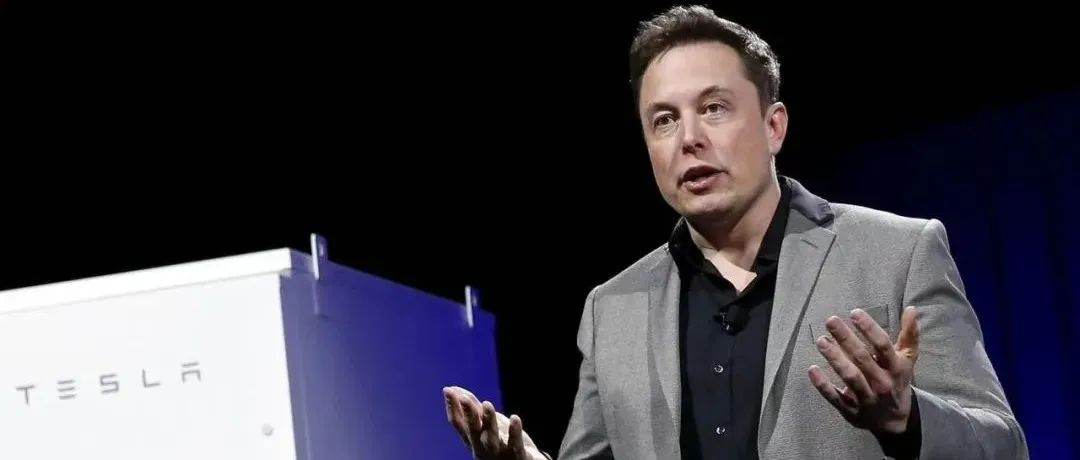Translated text in English Markdown
| Author | Leng Zelin |
|---|---|
| Editor | Wang Pan |
On June 5, 2022, Musk announced on social media that FSD Beta 10.12.2 will be expanded to 100,000 vehicles.
In fact, Tesla released FSD Beta 10.12 at the end of May. Musk stated that a lot of updates had been made to the autonomous driving core code, mainly for decision-making in scenarios of unprotected left turns and busy intersections.
At that time, however, it was only pushed to some employees and did not include vehicle owners who had achieved driving standard. The latest version is now being pushed to 100,000 vehicles.
During the recent “All-In-Summit” technology meeting, Musk also announced that he expects to significantly increase the number of people participating in FSD Beta testing this year, possibly even expanding to one million people.
Currently, the Tesla FSD Beta version is only available in the United States and Canada, and the European market will be Tesla’s next target. There is no further news about the Chinese market for the time being. However, with the upgrade of urban road navigation assistance driving in the second half of this year, Tesla FSD Beta may also have a chance to enter the domestic market.
“Zero Map Data” Autonomous Driving
FSD Beta 10.12 version of Tesla mainly upgraded the decision-making framework for “unprotected left turn scenarios”, enhancing robustness, improving visibility during idle mode, better integrating target trajectory prediction information during lane selection planning, and reducing prediction errors in speed and angle for pedestrians and cyclists.
Among them, the most obvious improvement is the enhancement of visualization capabilities. The latest UI system can recognize the state of the vehicle door being opened and mark it with an orange color, while also improving modeling refinement.
A frequent word used by many upgraded vehicle owners on social media is “smooth”.

In addition, Musk mentioned that version 10.13 of FSD Beta will also feature smooth intersection control, particularly in long left turn scenarios.
Importantly, in a few months, FSD will begin to handle “zero map data” roads.
As Tesla itself does not use high-precision maps, “zero map data” roads here have only two options: general navigation maps or internal roads.
In a subsequent response, Musk clarified that he was referring to the latter, specifically in situations where GPS signals are unavailable, where the car will use inertial measurement, wheel motion, and visual navigation to achieve autonomous driving.This capability is similar to the VPA memory parking function of XPeng Motors in China, but there may still exist differences between the two in terms of specific functions and implementation methods.
The XPeng VPA function requires the driver to manually drive along a route and then reproduce the memorized route through the “semantic map + matching algorithm” developed by XPeng. During the manual driving process, the vehicle collects and identifies parking lot environmental elements and vehicle position information through sensors, and integrates them to generate an aerial view of the environment. When the function is enabled, the driving route is adjusted through mutual comparison.
Musk did not mention whether the vehicle needs to learn in advance or if it is necessary to learn in every situation. However, XPeng VPA only supports underground parking lots, while Musk’s statement includes scenes such as above-ground parking lots and hotel entrances.
Photon Travel speculates that, on the one hand, because the above-ground parking lot is greatly affected by weather changes, and, on the other hand, there are few “landmark elements” that can be collected by vehicles in the above-ground parking lot, it is difficult to build a reliable semantic map and achieve mutual comparison, so XPeng Motors did not include this scene in the VPA function.
Although XPeng updated its cross-floor memory parking (VPA-L) earlier this year, it was based on the introduction of Lidar. The existence of Lidar adds a new dimension to the previous 2D information, allowing information to be read even when the camera angle changes due to the vehicle’s uphill and downhill movements, which Tesla can only rely on pure visual solutions.
From this perspective, Musk’s “zero map data” driving and the implementation method of mainstream domestic manufacturers are not the same.
It is worth noting that XPeng can also achieve automatic parking without learning through a method similar to “crowdsourcing”. In XPeng’s memory parking function, users are supported to share and the official recommends (such as XPeng charging pile route) routes, as well as the newly updated function for parking along the way.
When there are enough shared routes that cover a wide enough range, the vehicle can also achieve automatic parking in most unfamiliar parking lots. Under compliance, it is not ruled out that XPeng may encourage users to upload memory parking routes through incentives in the future.
Involved in the “Ghost Brake” Event
Since the beginning of this year, almost all mainstream automakers’ new cars have adopted a scheme consisting of a camera, Lidar, and high-precision maps, while Tesla has been insisting on a pure visual approach.
The debate between the Lidar fusion algorithm and the pure visual algorithm has never stopped, and there is currently no conclusion as to which is better. The former has higher hardware and surveying requirements, while the latter has higher requirements for single-car algorithms and intelligence.Just a few days before Tesla’s large-scale release of FSD 10.12.2, the National Highway Traffic Safety Administration (NHTSA) reported in a document that since February of this year, complaints about Tesla’s accidental braking have risen from 354 to 758.
At the same time, NHTSA has requested that Tesla respond to this issue by June 20th. However, we have yet to receive Tesla’s response to the matter, and have only received news of Musk’s 10% staff reduction.
According to NHTSA’s investigation into about 416,000 Tesla Model 3 and Model Y reports, this phenomenon of “ghost braking” will suddenly automatically brake when driving at high speeds, which is not the same type of incident as the “brake failure” that domestic car owners had previously complained about.
However, the upgrade note in version 10.12 mentions that by better integrating lane structure and recognition information of yellow traffic lights, the incidence of misbraking caused by traffic lights has been reduced.
Of course, although domestic mainstream automakers claim that they will gradually achieve city navigation-assisted driving this year, it will also be implemented in batches and requires conditions such as calibration, testing, and administrative approval of high-precision maps.
At present, the specific capabilities have not been verified, and there have been many accidents in navigation driving on high-speed or urban expressways relying on high-precision maps. At present, neither approach has emerged as a clear winner, and autonomous driving still faces long and arduous challenges.

This article is a translation by ChatGPT of a Chinese report from 42HOW. If you have any questions about it, please email bd@42how.com.
